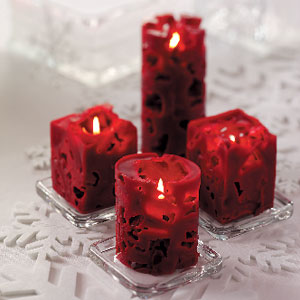Winter is a magical time of year, with its glistening snow and frost-covered landscapes. It’s the perfect time to cozy up by the fire and enjoy the warmth of candles. If you’re looking for a unique candle-making project to try this winter, why not make ice candles?
Ice candles are made by pouring hot wax over ice, creating a beautiful and delicate lacy effect. The ice melts as the wax hardens, leaving behind a unique and stunning candle. Here’s how to make your own ice candles. See How to Make Candles at Taste of Home for full instructions.
Materials:
Candle wax (paraffin, soy, or beeswax)
Candle wicks
Ice (in various sizes and shapes)
Double boiler
Thermometer
Fragrance oil (optional)
Candle dye (optional)
Instructions:
Melt the wax
Begin by melting your candle wax in a double boiler. Use a thermometer to monitor the temperature of the wax, and keep it between 170-180 degrees Fahrenheit. You can use paraffin wax, soy wax, or beeswax, depending on your preference.
Prepare the ice
While the wax is melting, prepare your ice. You can use ice cubes, crushed ice, or larger ice blocks, depending on the size and shape of the candle you want to make. Place the ice in a container or mold, leaving a space in the center for the wick.
Add fragrance and color (optional)
If you want to add fragrance or color to your candle, you can do so now. Add a few drops of fragrance oil to the melted wax and stir well. You can also add candle dye to achieve the desired color.
Insert the wick
Once the wax has reached the desired temperature and consistency, insert the wick into the center of the ice mold. Make sure the wick is straight and centered.
Pour the wax
Carefully pour the melted wax over the ice, making sure to cover it completely. The hot wax will melt the ice, creating a beautiful and unique lace effect. Make sure to pour slowly and evenly to avoid creating air bubbles.
Let the candle cool and harden
Once you have poured the wax, let the candle cool and harden completely. This may take several hours, depending on the size and shape of the candle. You can speed up the process by placing the candle in the refrigerator or freezer.
Remove the candle from the mold
Once the candle has hardened, you can remove it from the mold. Gently break away the ice, being careful not to damage the delicate lace effect. Trim the wick to the desired length.
Enjoy your new ice candle!

